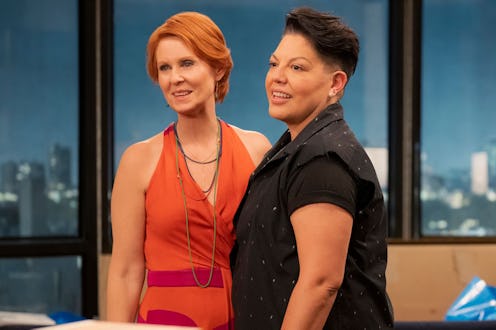TV & Movies
Sex & The City Is Still Failing Bisexual People
Even decades later, the show wants characters to “pick a side and stay there.”

In the original Sex and the City series, a few scenes are so offensive that you wonder how they made it onto the small screen. In one, Carrie says she only wears “ghetto gold” jewelry for fun; in another, Samantha sports a “Foxy Brown” afro; and notably, in a 2000 episode, Carrie’s date with a bisexual man leads her to declare, “I’m not even sure bisexuality exists. I think it’s just a layover on the way to Gay Town.”
It’s easy to take these episodes with a grain of salt and dismiss their ignorance with the excuse: It was 20 years ago; they didn’t know any better. But even today, the reboot, And Just Like That..., continues to fail the LGBTQ+ community — bisexual people in particular — by clinging to an outdated, binary definition of sexuality.
SATC was gospel for many millennials who grew up watching it, but despite it being groundbreaking many other respects, the views expressed in its reboot are a reminder that these characters are not us — and we are not them. Although AJLT has made efforts to incorporate diversity into the series by adding (often underdeveloped) Black and nonbinary secondary characters, the show’s views on bisexuality have not changed. Miranda receives her long-overdue queer arc, after being queer-coded in the original series, but she’s met with the same bisexual stereotypes she herself perpetuated in 2000. (“It’s not hot, it’s greedy! He’s double-dipping.”)
After Miranda’s breakup with Che Diaz in Season 2’s sixth episode, she has lunch with the girls, just like old times. In what’s essentially a recreation of the original show’s brunch scene, Charlotte says, “You don’t even know if you’re gay,” and tells Miranda she needs to “figure it out,” as though liking both men and nonbinary people isn’t a valid sexuality. The line isn’t far from her response to Carrie’s bi boyfriend, 23 years earlier: “I’m very into labels: gay, straight. Pick a side and stay there.”
Later, in the same AJLT episode, Miranda compares her sexuality to famous authors, declaring: “Strong, sexy women are my thing! I’m done with Dickens!” This, too, is almost verbatim what Samantha said in SATC when she dated artist Maria. During that relationship, her first with a woman, Samantha says things like: “Ladies, I’m a lesbian,” and “I’m done with dick” — despite the fact that she also dates, has sex with, and falls in love with men throughout the show. Apparently, in the SATC universe, you can be either gay or straight, and anything else is just confusion — even though almost half of Americans believe that sexuality is a scale (including 46% of Baby Boomers and 47% of Gen X, the generations into which these characters fall).
For most of AJLT’s second season, the conversation around sexuality barely progresses beyond these reductionist views. So far, Miranda has been inaccurately described as a “lesbian” and “confused” on several occasions, but the words “bisexual,” “pansexual,” or “queer” are rarely included in those discussions. One of the only times they are used is in Episode 10, when Che performs a deeply un-funny stand-up routine — at a queer comedy club, no less — disparaging Miranda for attempting to figure out her sexuality as an adult.
“She was so confused,” Che says meanly before imitating Miranda. “Am I queer? Am I bi? Am I les?” they asked, as though seeking the answer to those questions is something to be mocked. After dubbing Miranda “straight,” Che laughs at her for exploring “the whole menu of LGBTQIA+” labels in an attempt to find the one that fits her best. “I’ll take queer, with a side of bi, no mayo,” they finish to peals of laughter.
In a real New York City queer comedy club, the crowd undoubtedly would have booed such an offensive set. Taking the time to discover your identity is a foundational experience of the LGBTQ+ community, and liking men and nonbinary people and women doesn’t necessarily mean you are “confused” or “questioning” — bisexuality exists, and that’s what the show fails to represent.
This “one or the other” mindset erases the rest of the sexuality spectrum. It’s clear that, though the SATC writers are now targeting a more socially-aware audience, the outdated, harmful views on display more than 20 years ago are still being represented through the invalidation of Miranda’s sexuality.